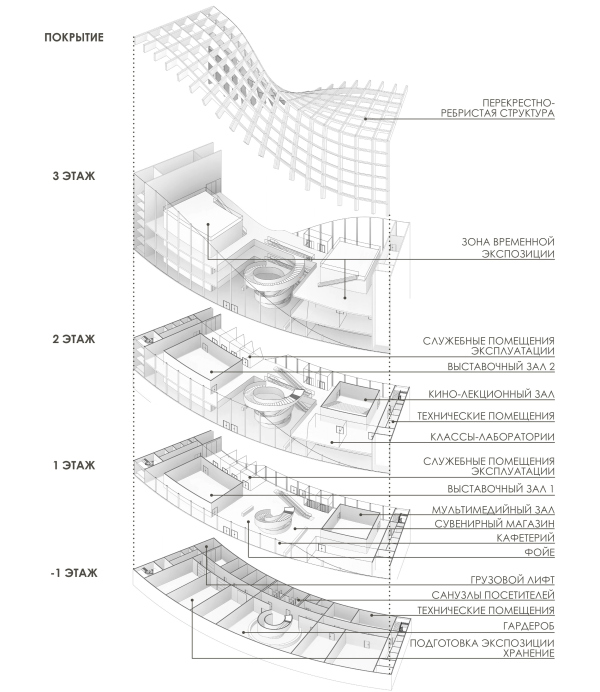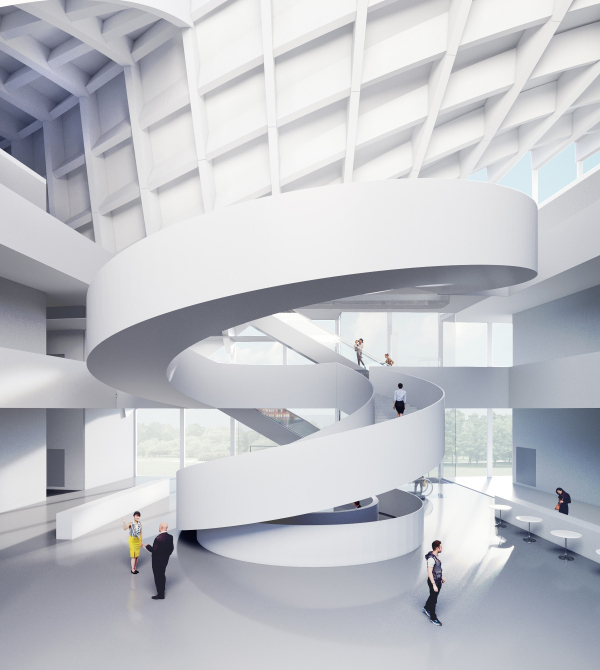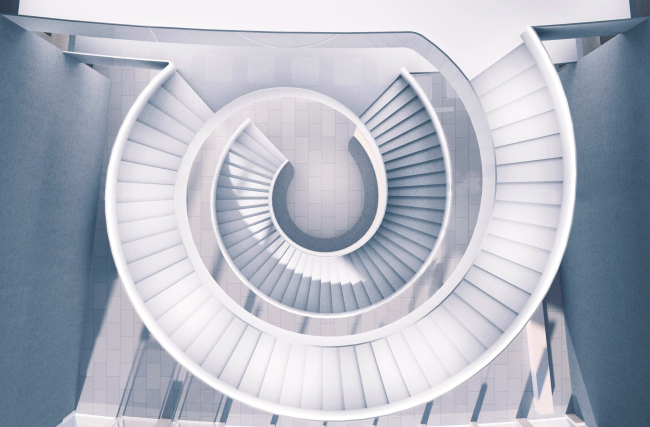|
Published on Archi.ru (https://archi.ru) |
|
| 06.08.2021 | |
|
Kasimir from Kemerovo |
|
|
Alyona Kuznetsova |
|
| Studio: | |
| Arena | |
|
The project of the branch of the Russian Museum for the Siberian Art Cluster is based on the ideas of Suprematism: basic shapes, and dynamism of color and form. In 2018, a presidential decree initiated the creation of cultural clusters in four regional centers of Russia: Kaliningrad, Vladivostok, Sevastopol and Kemerovo. The clusters include cultural and educational, theater, concert, museum and exhibition areas; some of them are assigned to local institutions, while in others, branches of the Hermitage, the Tretyakov Gallery, the Mariinsky Theater and other world famous institutions are developing their activities. One of the side effects of the project – the appearance of modern architecture in regional cities – is similar to the one that happened before the Soccer World Championship when the member cities got airports, stadiums and hotels, sometimes designed by well-known architects. The kemerovo branch of the Russian Museum. Master planCopyright: © PI ARENAThe kemerovo branch of the Russian MuseumCopyright: © PI ARENAThe first sketches by PI ARENA chiefly addressed the city context: according to the authors of the project, Kemerovo is a textbook example of Soviet architecture – its periods can be traced here like annual rings of a tree. However, the coworkers of the Russian Museum asked the architects to come up with an image that would easily identify the status of the building. Then the architects turned to the ideas of suprematism, building up the following logical passage: the museum hosts the biggest collection of Russian avant-garde paintings, whose best-known and recognizable representative is Kasimir Malevich, whose most ideologically charged work is, of course, “Black Square” that imbues the artist’s key ideas of the meaning of color and shape. In addition, the aesthetics of suprematism seems appropriate for the Soviet industrial city founded in 1918. The kemerovo branch of the Russian MuseumCopyright: © PI ARENAThe basis for shape making was constituted by the principles of dynamic form and color, developed by Kasimir Malevich, and in this respect one could say that PI ARENA is indeed about a synthesis of architecture and painting. The volume of the building is a slightly bent cuboid that follows the line of the landscape, and was created by multiplying a flat square. The side walls are media screens that broadcast an image of a red and black square, as well as the information about the current exhibitions and events. The roof is composed of two bent triangles, which you can consider to be variations of another basic figure of suprematism – a cross of intersecting rectangles. Yet another primary figure, a circle, is situated inside of the building, and is a reference to Guggenheim museums. The kemerovo branch of the Russian Museum. Form makingCopyright: © PI ARENAThe dynamic and sculptural character of the building is further enhanced by the “ribbons” of the roof – these ribbons are made of metallic panels, whose shade of color changes depending on the weather conditions, as well as the viewing angle. Wherever the ribbon detaches itself from the ground, as it was picked up by the wind, the observer can see the inner structure of the building, and in this diagonal, superimposed over the inner framework, one can discern an homage to another piece of museum classic – the Pompidou Center. The kemerovo branch of the Russian MuseumCopyright: © PI ARENAThe kemerovo branch of the Russian MuseumCopyright: © PI ARENADespite the parametric shape, the building stays symmetrical. On the inside, it is composed of two wings of an approximately equal size: the exposition and the educational/research ones, between which a striking-looking spiral staircase is situated, which connects all the levels. All of the auxiliary rooms are situated in the underground floor, and the foyer is a pass-through one – one can enter the museum both from the side of the city and the embankment. On the third floor level, the exposition wing has a dull white “box” – the perfect expo space, convenient both for curator ideas and for humidity-, temperature-, and light-sensitive works of art. From the outside, the “box” is surrounded by public and staff premises. The educational part has a similar structure and includes a video/lecture and a multimedia halls, auditoriums, and laboratories.  The kemerovo branch of the Russian Museum. StructureCopyright: © PI ARENA The kemerovo branch of the Russian MuseumCopyright: © PI ARENAWorking on a museum project is an important experience for any architectural company, and for ARENA, a company that is more known for projects of high-profile sports facilities, is one of the examples of broadening creative horizons. We will also note that the project was worked through as a real one ready for implementation. Of course, such companies as Coop Himmelb(l)au, are hard to compete with, but PI ARENA does have its strong sides: not claiming to create the “Bilbao effect” (which maybe will or maybe won’t take off in Kemerovo) it presents a meditation on the subject of the identity of the city founded in the XX century, and helps establish cultural ties between the regions situated thousands of miles apart. |
|





